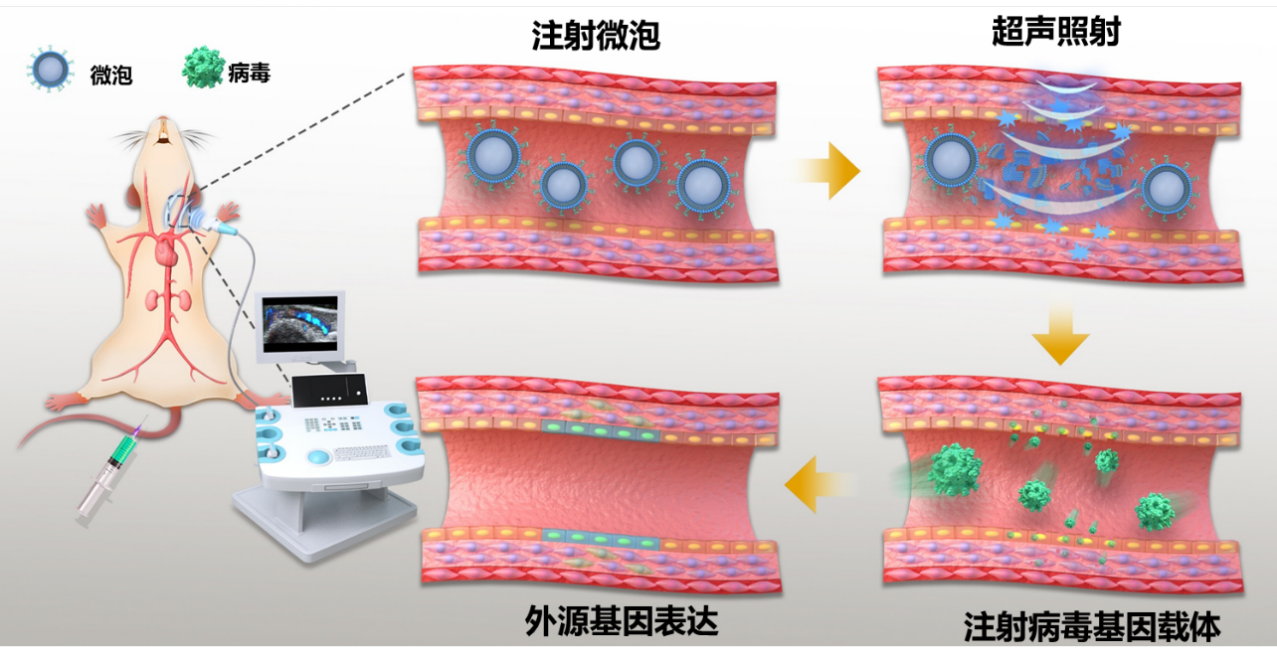Professor Dai Zhifei's team achieved gene regulation of arterial endothelial cells in vivo by ultrasound-guided method for the first time
From: Prof. Dai Zhifei's Team
Dysfunctional vascular endothelial cells (ECs) are the pathophysiological basis of many cardiovascular diseases, including atherosclerosis. Regulating the function of ECS by introducing exogenous genes is expected to achieve the treatment of atherosclerosis. However, effective methods for transgene expression in vascular endothelium are still lacking. Professor Zhifei Dai and his team at Peking University College of Future Technology used clinical diagnostic ultrasound and microvesicular ultrasound contrast agent combined with adeno-associated virus (AAV) vector to establish a new strategy for ultrasound image-guided transgene delivery of in vivo arterial endothelial cells (UMGAAV), which for the first time realized spatial regulation of transgene expression of arterial endothelial cells in a non-invasive manner. The treatment of carotid plaque was achieved in a mouse model. The results of the study were recently published in the Signal under the title "Spatial control of robust transgene expression in mouse artery endothelium under ultrasound guidance. Published online in Journal of Transduction and Targeted Therapy (IF="38.1).
To establish the UMGAAV strategy, the research team used a clinical diagnostic ultrasound imaging system operating at 4.4 MHz, which is also used for clinical carotid ultrasound imaging. In color Doppler mode, the carotid arteries of the mice can be clearly seen, and the area of interest can be selected on the image so that the ultrasound can be focused on that area. After injecting the microbubble, the microbubble can be selectively exploded in the area of interest under the action of ultrasound emitted by the imaging probe, so as to improve the permeability of the tissue in the area. After injection of AAV vector, the highly specific expression of foreign genes in this region could be achieved. The experimental results showed that ultrasound could increase the gene expression in endothelial cells by about 24 times, and the high expression could be maintained for more than 8 weeks. In addition, the effect of ultrasound also increased the expression of foreign genes in the inner and outer membranes of blood vessels by about 86 times, suggesting that UMGAAV can also be used to target gene delivery in other blood vessel cells, such as smooth muscle cells.

In addition to the carotid artery, UMGAAV could theoretically be used to deliver foreign genes to all blood vessels that can be seen by ultrasound imaging. The team successfully validated the UMGAAV strategy in rats' abdominal aorta and femoral arteries. Finally, the application of UMGAAV in the treatment of atherosclerosis was further tested by UMGAAV-mediated KLK10 gene (a newly identified atherosclerosis suppressor gene by the team) in a mouse model of carotid artery partial ligation of atherosclerosis. Targeted delivery of eLife 2022, 11, e72579 significantly inhibited carotid plaque formation in mice.
In conclusion, Professor Dai Zhifei's team established a new method to achieve the selective expression of foreign genes in the arterial endothelia through ultrasound image guidance. The ultrasonic imaging instrument used in this method has been widely used in clinical practice, the AAV gene carrier has been verified in several clinical trials, and the microbubble ultrasound contrast agent was independently developed by Professor Zhifei Dai's team, and has been approved by the China Food and Drug Administration. Multi-center phase III clinical trials are being carried out. Therefore, UMGAAV has good clinical translational potential.
The co-first authors of the paper are Renfa Liu, postdoctoral fellow, and Shuai Qu, PhD student, Class of 2018, Peking University College of Future Technology; Professor Zhifei Dai, Peking University College of Future Technology, is the corresponding author; and Professor HanjoongJo, Georgia Institute of Technology and Emory University, also contributed to the smooth progress of this research. This research was mainly supported by the National Natural Science Foundation of China (No.81930047; No. 82102062) and China Postdoctoral Science Foundation (2020TQ0008).
Link: https://www.nature.com/articles/s41392-022-01031-w
STTT (IF="38) | Dai Zhifei team at Peking University achieved the first transgenic expression in vivo arterial endothela through a non-invasive method




